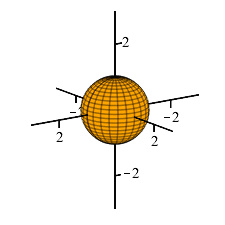18. Related Rates
a. For Variables Related by an Equation
When two quantities are related and one of them changes, the other changes in a prescribed way. If we know the rate of change of one quantity, we can calculate the related rate of change of the other quantity. If one variable is given explicitly as a function of the other variable, then the related rate can be found simply by using the chain Rule. For example:
The volume of a sphere is \(V=\dfrac{4}{3}\pi r^3\) where \(r\) is the radius.
Currently, the radius is \(r=2\,\text{cm}\) and hence the volume is
\(V=\dfrac{32}{3}\pi\,\text{cm}^3\).
(a) If the radius is increasing at
\(\dfrac{dr}{dt}=5\,\dfrac{\text{cm}}{\text{sec}}\),
what is the rate of change of the volume?
(b) Conversely, if the volume is increasing at
\(\dfrac{dV}{dt}=6\,\dfrac{\text{cm}^3}{\text{sec}}\),
what is the rate of change of the radius?

We differentiate the volume equation remembering that \(r\) and \(V\) are
both functions of time and using the Chain Rule:
\[
\dfrac{dV}{dt}=4\pi r^2\dfrac{dr}{dt}
\]
(a) Since \(r=2\) and \(\dfrac{dr}{dt}=5\), we calculate:
\[
\dfrac{dV}{dt}=4\pi (2)^2(5)=80\pi\,\dfrac{\text{cm}^3}{\text{sec}}
\]
(b) Conversely, since \(r=2\) and \(\dfrac{dV}{dt}=6\), we calculate:
\[
6=4\pi (2)^2\dfrac{dr}{dt} \qquad \text{or} \qquad
\dfrac{dr}{dt}=\dfrac{3}{8\pi}\,\dfrac{\text{cm}}{\text{sec}}
\]
The two variables are not always related by an explicit function. They may be implicitly related. For example:
Suppose \(x\) and \(y\) satisfy the equation
\[
x^3y=6-x^2y^2
\]
We are currently at the point \((x,y)=(1,2)\).
(a) If the rate of change of \(x\) is currently \(\dfrac{dx}{dt}=3\), find the
current rate of change of \(y\).
(b) If the rate of change of \(y\) is currently \(\dfrac{dy}{dt}=6\), find the
current rate of change of \(x\).
We first check that the point \((x,y)=(1,2)\) satisfies the equation. The left
side is \(\text{LHS}=(1)^3(2)=2\) while the right side is
\(\text{RHS}=6-(1)^2(2)^2=2\).
So the point satisfies the equation. If it didn't, you should complain to your
instructor, that the problem makes no sense.
We now implicitly differentiate the relation equation using the Product and
Chain Rules:
\[
3x^2\dfrac{dx}{dt}y+x^3\dfrac{dy}{dt}=-2x\dfrac{dx}{dt}y^2-x^22y\dfrac{dy}{dt}
\]
We can now plug in the known current values and solve for the unknown current
values.
(a) Currently, \(x=1\), \(y=2\) and \(\dfrac{dx}{dt}=3\). So:
\[
3(1)^2(3)(2)+(1)^3\dfrac{dy}{dt}=-2(1)(3)(2)^2-(1)^22(2)\dfrac{dy}{dt}
\]
We solve for \(\dfrac{dy}{dt}\):
\[\begin{aligned}
18+\dfrac{dy}{dt}&=-24-4\dfrac{dy}{dt} \\
5\dfrac{dy}{dt}&=-42 \\
\dfrac{dy}{dt}&=-\,\dfrac{42}{5}
\end{aligned}\]
(b) Currently, \(x=1\), \(y=2\) and \(\dfrac{dy}{dt}=6\). So:
\[
3(1)^2\dfrac{dx}{dt}(2)+(1)^3(6)=-2(1)\dfrac{dx}{dt}(2)^2-(1)^22(2)(6)
\]
We solve for \(\dfrac{dx}{dt}\):
\[\begin{aligned}
6\dfrac{dx}{dt}+6&=-8\dfrac{dx}{dt}-24 \\
14\dfrac{dx}{dt}&=-30 \\
\dfrac{dx}{dt}&=-\,\dfrac{15}{7}
\end{aligned}\]
Suppose \(p\) and \(q\) are related by \(\dfrac{p}{q}=\dfrac{3}{2}+\dfrac{q}{p}\). Currently, we know \(p=4\), \(q=2\) and \(\dfrac{dq}{dt}=3\). Find \(\dfrac{dp}{dt}\).
\(\displaystyle \dfrac{dp}{dt}=6\)
We first verify that \(p=4\) and \(q=2\) satisfies the relation:
\[\begin{aligned}
\text{LHS:}\qquad&\dfrac{p}{q}=\dfrac{4}{2}=2 \\
\text{RHS:}\qquad&\dfrac{3}{2}+\dfrac{q}{p}=\dfrac{3}{2}+\dfrac{2}{4}=2
\end{aligned}\]
which are equal.
We now differentiate the relation \(\dfrac{p}{q}=\dfrac{3}{2}+\dfrac{q}{p}\)
using the Quotient Rule:
\[
\dfrac{q\dfrac{dp}{dt}-p\dfrac{dq}{dt}}{q^2}=\dfrac{p\dfrac{dq}{dt}-q\dfrac{dp}{dt}}{p^2}
\]
Next we plug in the known values \(p=4\), \(q=2\) and \(\dfrac{dq}{dt}=3\)
and solve for \(\dfrac{dp}{dt}\):
\[\begin{aligned}
\dfrac{2\dfrac{dp}{dt}-4\cdot3}{2^2}&=\dfrac{4\cdot3-2\dfrac{dp}{dt}}{4^2} \\
32\dfrac{dp}{dt}-64\cdot3&=16\cdot3-8\dfrac{dp}{dt} \\
40\dfrac{dp}{dt}&=240 \\
\dfrac{dp}{dt}&=6
\end{aligned}\]
Heading
Placeholder text: Lorem ipsum Lorem ipsum Lorem ipsum Lorem ipsum Lorem ipsum Lorem ipsum Lorem ipsum Lorem ipsum Lorem ipsum Lorem ipsum Lorem ipsum Lorem ipsum Lorem ipsum Lorem ipsum Lorem ipsum Lorem ipsum Lorem ipsum Lorem ipsum Lorem ipsum Lorem ipsum Lorem ipsum Lorem ipsum Lorem ipsum Lorem ipsum Lorem ipsum